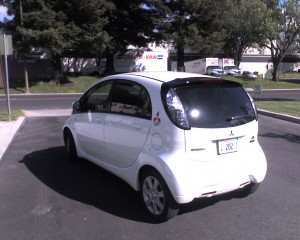 By John Addison (update 11/3/11; original 6/4/10)
By John Addison (update 11/3/11; original 6/4/10)
Test Drive of Japan’s Most Popular Electric Car
Fortunately, the new 2012 U.S. Mitsubishi i will have the steering wheel on the standard left side, because I am struggling with this test drive of the 2010 iMiEV Japanese version. Steering from the right-hand side is not so bad, but every time I use the “turn signal lever” the windshield wipers start flying. This is going to be a safe test drive, because the other drivers on this San Jose street are giving me lots of room.
Bring on the traffic; this little car has plenty of acceleration due to the torque of the electric motor. Although it is only 2,276 pounds, it feels solid due to a low-center of gravity with the lithium batteries embedded in the floor of the vehicle and the electric motor in the rear, providing real-wheel drive. Mitsubishi has done a good job of balancing the vehicles weight, which is easier to do in an electric car than one with an ICE with everything linked in the drive system. When I hit the brakes, stopping was quick but a bit uneven.
The 5-door hatchback feels like a roomy sub-compact inside. My 5 foot, 10 inch frame, fit easily in the driver’s seat and in the back seat of this 4-seater. The car is definitely designed for the urban environment. Parallel parking is a breeze, just nose in, turn off the car, and walk away. Mitsubishi is well experienced with small urban vehicles. Almost 40,000 of the 660 cc gasoline engine version of this vehicle have been sold since 2005.
Mitsubishi iMiEV is already being driven by 5,000 owners in Japan and Europe. Mitsubishi’s President Osamu Masuko drives this electric car today.
Bigger U.S. Mitsubishi i on Sale Now
Mitsubishi has started taking orders for the 2012 U.S. version of the popular iMiEV with a starting price of $29,125, over $5,000 less than the 2012 Nissan LEAF. Because Mitsubishi only uses a 16 kW lithium battery pack, they can undercut Nissan’s pricing with the LEAF using 24 kW.
The U.S. model will have steering wheel will be where you want it. The wheel base will be 5 inches wider for the U.S. market, but the micro-compact will still be able to get those precious city parking spaces that no other car can take by the smart. The more powerful U.S. version will have an electric range of 85 miles between charging in real world driving. Mitsubishi cautions that some of its competitors are advertising ranges that will not be experienced by most drivers. The Mitsubishi i includes an Eco mode that helps range by limiting excess power going to the motor and captures more regen energy on downhill. The high-energy batteries are made by Lithium Energy Japan, a joint venture company of GS Yuasa Corporation, Mitsubishi Corporation and Mitsubishi Motors Corporation.
Living in San Francisco, I see Mercedes smart cars everywhere, boastfully perched in neglected parking spots, saving the owners $20 per day in parking lot fees. Soon those smart cars will have to race for the spots and the Mitsubishi electric car can beat them every time.
Specfications
- Dimensions (L x W x H) = 133 x 58 x 63 (2012 USA expected to be 5″ wider)
- Vehicle Weight = 2,376 lb (2010; 2012 USA expected to add 100 to 200 lb)
- Maximum Speed = 80 mph
- Electric Range 85 miles (62 miles EPA adjusted)
- Charge Time
- 6 to 7 hours with J1772 (220v / 15 amp)
- 14 hours (110v / 15 amps)
- 80% in 30 min (2012 = 18 min) with Fast Charger (Level 3 200v / 50kW TEPCO)
- Motor = 64 hp (47kW) Permanent Magnet Synchronous
- Torque 113 lb-ft
- Lithium Batteries = 16 kWh with 88 cells
